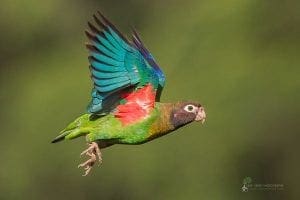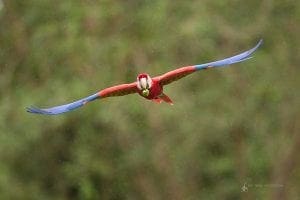
ISO : What You Need to Know
Though the light was low for this sunrise shot of a beach in the Gandoca-Manzanillo Wildlife Refuge, I was working from a tripod. I used a low ISO value of 50. As a rule of thumb, always try to use the lowest ISO possible.
For men and women of a certain age, the word “film” will ring a bell (I shot it for one year myself!). If you are of that certain age, you might recall that films had different speeds. On a sunny day, you were told to use 100 speed film, and in a dark wedding reception hall your photo store clerk probably recommended 800 speed film. The key is that the former absorbed less light (perfect for that sunny day at the park) while the latter was more sensitive to light (great to capture your cousin making a fool of himself on a wedding reception dance floor). This difference in light absorption was made possible by the chemical composition of the film itself.

Flying birds such as this scarlet macaw are fast. I used a high ISO value of 1000 to capture this action.
With digital cameras, there is a setting called ISO, and it works the same way except that the variations in sensitivity are achieved by cranking the signal gain up or down. Wait … what? Put simply, when you take a picture with a digital camera, light (photons) hits the image sensor and is absorbed by tiny photosites. When the photons hit, they create an electrical charge that is passed on to the image processor within the camera. When you use a high ISO value, that electrical charge is amplified, much like the sound when you crank the volume up on a stereo system.
So, why not just set your ISO as high as you can to ensure sharp pictures under any conditions? As with most things in life, there is no free lunch here. Just as loud volume on your favorite jam produces static, higher ISO settings on your digital camera produce more noise, meaning your photos will look grainy and have a loss of detail. This is due to the amplification described above, so you’ll need to make informed choices about the best ISO setting for a given situation.

Flying birds such as this brown-hooded parrot are fast. I used a high ISO value of 1000 to capture this action.
Every time you double the ISO, you double the sensitivity of the sensor. An ISO value of 200 means the sensor will be twice as sensitive to light as ISO 100, absorbing twice as much light in the same amount of time. ISO 400 absorbs twice as much light as ISO 200, and so on.
For smartphone cameras, you’ll probably see objectionable noise at ISO 800. For the best pro cameras, ISO 25,600 can yield publishable photos. Get to know your camera and determine where the noise becomes unacceptable. As a rule of thumb, always try to use the lowest ISO possible. But, if you’re in a dark Costa Rican rainforest without a tripod or if you’re trying to capture action, you’ll want to think about raising your ISO.

